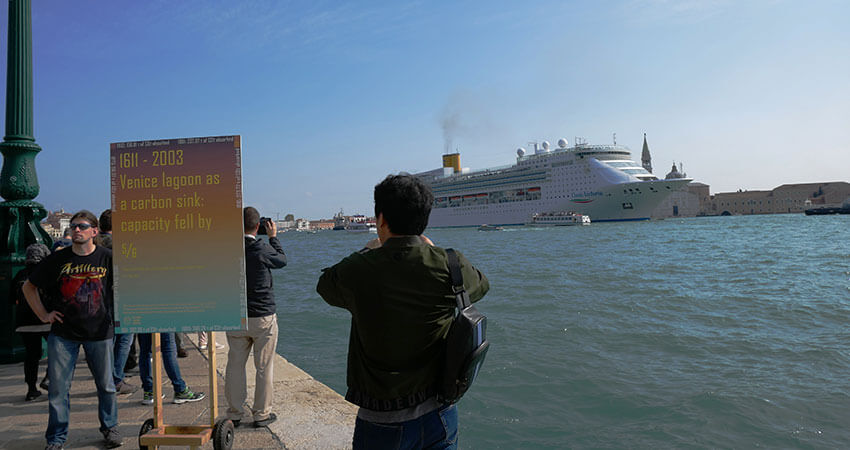Text by Benedetta d’Ettorre

Venice-based artists’ collective Barena Bianca brings to the Imperial College CLCC Foyer Gallery Atensión!, an installation that catalyses the power of language to respond to the programme of events part of Humanities@70.
The artworks on display are the result of the visual elaboration of historical data of various trends associated with the Venetian Lagoon: the erosion of saltmarshes, flooding frequency, the capacity of the lagoon to absorb CO2 and the diminishing population. Barena Bianca processed raw data from the 17th century to today to transform them into abstract images of colour gradients. Each poster combines statistical information – to which each phase of the gradient corresponds – to a value that intersects the others, forming shades of colour that become more or less intense depending on the proportions of the represented data. Each poster juxtaposes quantitative data and a quote by a specific thinker of the past, relating either to the city of Venice or the whole world.
What was once prophesized in words and metaphors, now translates into numbers. This creates an unsettling mirrored image of the romantic projection of poets and philosophers that is echoed by scientific and statistical observation of the future in Venice, resonating globally in the age of Anthropocene and climate’s Great Acceleration. Atensión! is designed each time to be site-specific, in fact, it only works when it is put in dialogue with its context.
In Venice, the artists carried around the posters on self-made carts made with recycled materials, trying to pass through crowds in the city’s narrow streets (calli). They re-enacted a daily scene, almost a survival ritual in Venice: locals, needing to move quickly through the city, attract distracted passersby’s attention by shouting in Venetian dialect “atensión!”—literally a call to pay attention, as they are trying to pass through.
In the CLCC Foyer Gallery, the installation works in a similar way. The installation is positioned in a transitory space. However, it relies on its visual language to attract general visitors, Imperial staff, and students’ attention to the powerful communication that art and sciences can achieve when they are in dialogue. Regular floodings are not new in Venice. However, their frequency and intensity have recently increased to the point that last November’s flooding hit the world’s headlines as the worst flooding in over 50 years.
The posters are accompanied by photographic documentation of the performances in specific sites of Venice: a yacht harbour, the large Canale della Giudecca where cruise ships pass, the ancient Greenhouse. While the photos speak of a unique city, the increasing threats posed by climate change speak to all of us. Local and global issues are inextricably tied together.
This is also reflected in the choice of language for the posters: Italian or Venetian terms break through the English text. The former are used because they are unique to describe the Lagoon’s environment, whilst the English language functions as a lingua franca allowing people to communicate globally. Venice has a powerful symbolic meaning; whilst being one of the most famous and unique cities in the world, it is also one of the most fragile and difficult to protect.
Barena Bianca works as local activists and artists to raise awareness and protect their city. The exhibition today, asks us to pay attention to the human and natural costs of Venice’s unsustainable evolution; however, Venice’s survival only depends on the survival of the wider ecosystem.
There’ll be a public lecture at Imperial College on 10 March 2020, The art and science of saving Venice, where Jane da Mosto, Imperial alumna and founder of We are Here Venice, will explore the relationship between Venice’s past and future and ask How much of our fascination with Venice derives from its unique beauty and peculiar features, or is it a microcosm of global challenges mirroring the world and carrying the fate of humanity?
Atensión! is open until 13 March 2020.






